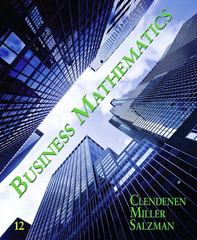Question
Joe and Phil need to make a presentation of a new product idea to their CFO. Their marketing department provided them with a projected unit
Joe and Phil need to make a presentation of a new product idea to their CFO. Their marketing department provided them with a projected unit of sales and price for the product over a 9 year economic life:
Year Unit Sales Unit Price
1 9000 1250
2 10000 1200
3 11000 1200
4 12000 1150
5 13000 1100
6 13000 1050
7 14000 1050
8 14000 1000
9 15000 1000
They also know the following: Additional inventory of $600,000 would be required. The company would increase their accounts payable by $300,000 and its accounts receivable by $200,000. The NWC of the firm would amount to 4% of sales expected next year, the WACC is 14.5%. Interest expenses on debt raised to fund the project is estimated to be $800,000 per year. The company's tax rate is expected to remain constant at 26%. Fixed costs are estimated to be $2,900,000 pe year while variable production costs per unit are expected to be $490. Finally, the salvage value is $1.7 million.
The depreciation schedule is as follows: Year 1: 14.29% Year 2: 24.49% Year 3: 17.49% Year 4: 12.49% Years 5 6 and 7: 8.93% Year 8: 4.45%
Modified ACRS Depreciation
Year Allowance
1 33.33% 20% 14.29%
2 44.44% 32% 24.49%
3 14.82% 19.20% 17.49%
4 7.41% 11.52% 12.49%
5 11.52% 8.93%
6 5.67% 8.93%
7 8.93%
8 4.45%
Requirements: 1. Make a Pro Forma Statement showing the annual cash flows resulting from the Lazy Mower project. Perform capital budgeting analysis with the projected cash flows to compute NPV, IRR, MIRR, and payback. Based on the results, what should Dan and Ron recommend?
2. On a separate worksheet, Make a pro forma statement to show how the cash flows would change if the sales forecasts were 20% worse (Pessimistic) and 20% better (Optimistic) than the stated forecast (base). How do the NPV and IRR change?
3. How sensitive is the Net Present Value of the project to the sales forecasts (-30% to +30 of the base by 5% increment), and to the variable costs (-30 to +30% of the base)? Find how bad the sales must be to have zero NPV.
4. How should the annual interest expenses of $650,000 be treated? Explain. Also note that the company had spent $600,000 in developing the prototype of the Lazy Mower and its related patent. Unless the company takes on the project, the patent can be licensed out for $25,000 a year. How should Dan and Ron treat these items in their capital budgeting analysis? If any of these costs is relevant to the capital budgeting analysis, how does it change the NPV?
5. Using the base case estimates calculate the cash, accounting, and financial breakeven of the Lazy Mower project. Interpret each one. For cash and accounting breakeven, use the first year only. For financial breakeven, assume a constant annual sales each year; so that you are computing the annual sales unit that would make the NPV of the project equal to zero.
Step by Step Solution
There are 3 Steps involved in it
Step: 1

Get Instant Access to Expert-Tailored Solutions
See step-by-step solutions with expert insights and AI powered tools for academic success
Step: 2

Step: 3

Ace Your Homework with AI
Get the answers you need in no time with our AI-driven, step-by-step assistance
Get Started


